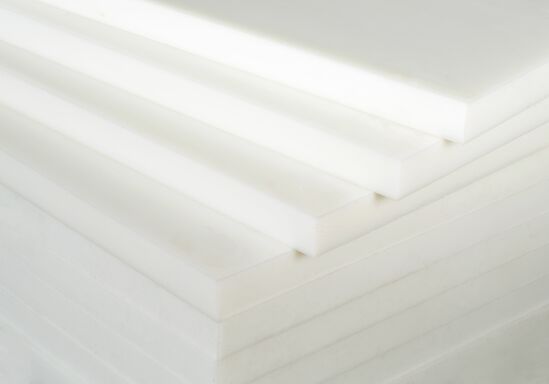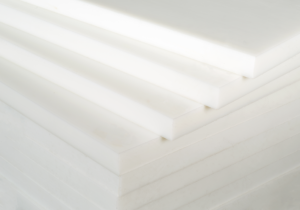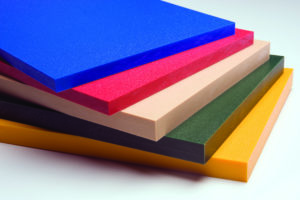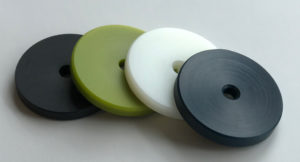UHMW sheets are a popular choice for many applications that require chemical resistance and the ability to stand up against constant wear and friction. It is important to understand the specific properties that make UHMW such a powerful option. This may allow you to more accurately compare your potential plastic options for each application and get the exact materials that are best suited for your industry and needs.

Whether you’re looking to purchase right away or just want to learn more about the best plastics for your industry, here’s a guide to UHMW chemical resistance, density, and the other qualities that make it stand out from other plastic materials.
UHMW Sheets – Material Properties
UHMW stands for Ultra High Molecular Weight Polyethylene, which is a thermoplastic. The sheets are a semi-crystalline material. UHMW retains its rigid structure until it reaches its melting point of about 180 degrees Fahrenheit. It offers a wide array of high-performance properties – in fact, the fact that it excels in so many different areas is what makes it such a popular choice with many businesses and organizations that utilize plastics. Here are just a few of the qualities where UHMW sheets stand out:
Density is perhaps the most notable quality of UHMW sheets. The particles in these sheets are bundled so tightly together, preventing them from separating when exposed to friction or impact. This gives UHMW a powerful combination of wear resistance and high impact strength. It doesn’t break apart when struck by a fast-moving object, and the surface doesn’t wear away when objects brush against it constantly. Many materials offer either impact strength or wear resistance, but UHMW is known for both.
The dense makeup of UHMW also makes it well-suited to stay together when exposed to a variety of harsh or unpredictable environments. Specifically, the material exhibits very low moisture absorption, so it does not easily break down when exposed to humidity or submerged in liquids. This makes it suitable for various marine applications. UHMW also retains many of its key physical properties when exposed to extreme temperatures. This material can be used in unheated facilities and is sometimes employed as an insulator around electrical wiring.
Then there is the chemical resistance of UHMW. Since the molecules of this plastic are so dense, it does not easily absorb chemicals, preventing sheets from breaking down, corroding, or changing their physical properties when exposed to various substances. This allows it to be easily cleaned, sanitized, and treated when necessary.
Because of all these properties, UHMW is an excellent general-purpose material for a number of applications in different industries. For example, due to its moisture and chemical resistance, UHMW is a great choice in food handling. It can even come in grades that are compliant with various food safety standards, like 3-A Dairy and USDA. And it can be used to produce conveyance mechanisms and material handling due to its impact strength and wear resistance. Other regulatory compliance standards that it can meet include ASTM/Mil-Spec, FDA, and UL-94 Flame Class.
UHMW vs. Other Plastics
There are many plastics that offer either high impact strength or wear resistance. Furthermore, there are others that provide moisture and/or chemical resistance. UHMW sheets stand out in the plastics market because of their ability to provide all these benefits in one type of material. There is no one right choice when it comes to investing in plastic materials, so it’s important to understand specifically how different options are different and how each one is typically used in your industry. Here’s how this high-performance plastic compares to a few similar options:
HDPE is most commonly compared to UHMW since they are both known for their high density. HDPE is both abrasion and chemical-resistant. UHMW provides extra toughness, which makes it better suited for various industrial applications.
Nylon is another plastic that sometimes gets compared to UHMW. It is a strong and stiff material that holds up well against wear and bearings. Both nylon and UHMW are common in industrial settings. Nylon offers benefits like noise reduction and smooth movement, making it ideal for parts like bearings and bushings. While UHMW is better suited for strips or sheets that experience a lot of friction.
Basically, UHMW offers tons of versatility as a general-use plastic, particularly in industrial, machining, and manufacturing settings. It is also common in chemical handling, marine settings, aerospace, and food and beverage handling. It may not be quite as impact resistant as polycarbonate or as chemical resistant as Teflon, but it provides a solid array of attributes that make it a top choice for any company needing a tough material.
At Polymershapes, we offer UHMW from industry-leading manufacturers, like Mitsubishi Chemical Advanced Materials. And we offer UHMW sheets in a variety of sizes, colors, and grades. You can even have sheets cut to your exact specifications, or purchase UHMW in other shapes like rods or tubes. Our knowledgeable team can also help you understand the exact qualities of UHMW vs. other plastics to ensure you get the best possible material for your specific applications. Our local facilities have access to a huge array of high-performance plastics from top manufacturers, so you can feel confident in your purchase and know that you’re getting the most relevant materials to suit your needs. Visit our website to find your local branch and reach out for a quote today.


